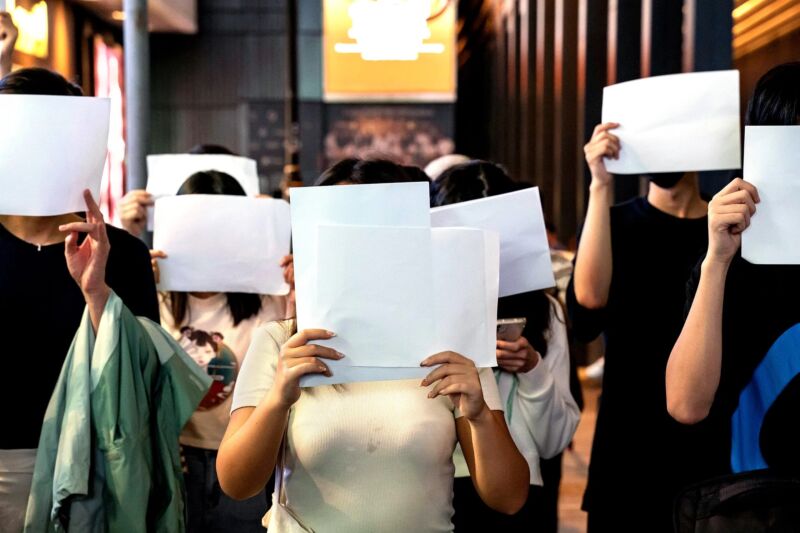
A week ago, demonstrators took to the streets of the northwestern city of Urumqi to protest China’s strict zero-COVID policy. That night, a much bigger wave of protest crested on Chinese social media, most notably on the super app WeChat. Users shared videos of the demonstrators and songs like “Do You Hear the People Sing” from Les Misérables, Bob Marley’s “Get Up, Stand Up,” and Patti Smith’s “Power to the People.”
In the days that followed, protests spread. A mostly masked crowd in Beijing’s Liangmaqiao district held up blank sheets of paper and called for an end to tough COVID policies. Across the city at the elite Tsinghua University, protesters held up printouts of a physics formula known as the Friedmann equation because its namesake sounds like “free man.” Similar scenes played out in cities and college campuses across China in a wave of protest that has been compared to the 1989 student movement that ended in a bloody crackdown in Tiananmen Square.

Unlike those earlier protests, the demonstrations that have roiled China in the past week were entwined with and spread by smartphones and social media. The country’s government has tried to strike a balance between embracing technology and limiting citizens’ power to use it to protest or organize, building up wide-ranging powers of censorship and surveillance. But last weekend, the momentum of China’s digital savvy population and their frustration, bravery, and anger seemed to break free of the government’s control. It took days for Chinese censors and police to tamp down dissent on the Internet and in city streets. By then images and videos of the protests had spread around the world, and China’s citizens had proven that they could maneuver around the Great Firewall and other controls.
“The mood on WeChat was like nothing I’ve ever experienced before,” says one British national who has lived in Beijing for more than a decade, who asked not to be named to avoid scrutiny from Chinese authorities. “There seemed to be a recklessness and excitement in the air as people became bolder and bolder with every post, each new person testing the government’s—and their own—boundaries.” He saw posts unlike those he’d seen before on China’s tightly controlled Internet, like a picture of a Xinjiang official bluntly captioned “Fuck off.”
Chinese netizens have built up a sense of what censors will and won’t allow, and many know how to skirt some Internet controls. But as the protests spread, younger WeChat users seemed to become unconcerned with the consequences of their posts, one tech worker in Guangzhou told Wired, calling on an encrypted app. Like other Chinese nationals quoted, he asked not to be named because of the danger of government attention. More seasoned organizers used encrypted apps like Telegram or shared to Western platforms, like Instagram and Twitter, to get the word out.
The anti-lockdown demonstrations began as unofficial vigils for the victims of a fatal fire in Urumqi, the capital of China’s northwestern Xinjiang province. The city had been under COVID lockdown restrictions for more than 100 days, which some observers believe hindered victims trying to escape and slowed emergency responders. Most, if not all, of the victims were members of the Uyghur ethnic minority, which has been subject to a campaign of forced assimilation that sent an estimated 1 million to 2 million people to reeducation camps.
The tragedy came as frustrations with zero-COVID policies were already starting to spike. Violent confrontations had broken out between workers and security at a Foxconn plant in Zhengzhou that manufactures iPhones. Scott Kennedy, of the Center for Strategic and International Studies, a think tank in Washington, DC, says that when he visited Beijing and Shanghai in September and October, it was clear that people had “grown weary” of measures like regular PCR testing, scanning QR “health codes” to go anywhere, and the constant specter of a fresh lockdown. “I’m not surprised that things have boiled over,” Kennedy says. The government in early November signaled some restrictions would soon loosen, but the Urumqi fire and news that COVID cases were rising again, he says, “pushed people over the edge.”
https://arstechnica.com/?p=1901755

